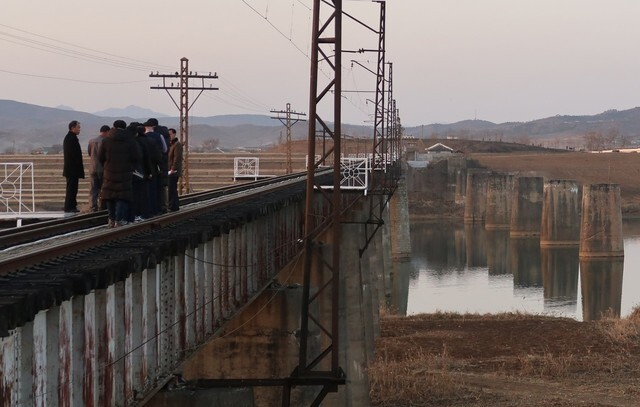hankyoreh
Links to other country sites 다른 나라 사이트 링크
Inter-Korean joint railway survey of 400km of Gyeongui Line completed on Dec. 5

“Conditions seem to be almost the same as what I saw on my previous trip [from Kaesong to Sinuiju in Dec. 2007 for a trial operation of the railroad]. Things haven’t gotten any better, but they don’t seem to have gotten much worse, either,” said Im Jong-il on the afternoon of Dec. 5 at Customs, Immigration and Quarantine at Dorasan in Paju, Gyeonggi Province.
Im, who is head of the Railway Construction Division at the South Korean Ministry of Land, Infrastructure and Transport, had just returned from a joint survey of 400km of tracks on the Gyeongui (Seoul-Sinuiju) railway line, which is part of an effort to modernize North Korean railroads and link them to the South Korean network.
“The North Koreans were very cooperative with the joint survey. They seem to have been well-prepared for our packed schedule because they’re very aware of the joint survey’s importance,” said Park Sang-don, head of the Second Dialogue Division at the Inter-Korean Dialogue Office at South Korea’s Ministry of Unification. Im and Park were co-leaders of the South Korean survey team.
When reporters asked whether it would be enough to repair the North Korean railroad tracks or whether they would have to be torn up and rebuilt from scratch, Im said, “I think that the final decision will require another survey, perhaps one that’s more thorough.”
The survey of the North Korean tracks on the Gyeongui Line was conducted by a North Korean locomotive and eleven passenger and freight cars (six from South Korea and five from North Korea), with the train generally moving at a speed ranging from 20 to 60km per hour.
“We moved more slowly on the section south of Pyongyang and rather quickly on the stretch north of Pyongyang, where there are international trains [moving to China],” Im said.
Though the South Koreans had not brought their own dining car, Im said that liaison officers from the two sides arranged for them to use the North Korean dining car without too much fuss. “The North Koreans had breakfast before we did, and then we switched the order in the evenings,” he explained.
“Overall, our survey focused on structural features – including railroad beds, tunnels and bridges – and the railroad operating system,” said Park Sang-don.
“There was no detailed discussion of the groundbreaking ceremony during the course of the joint survey,” Im said.
The train that was used in the survey on the Gyeongui Line will travel along the Pyongra (Pyongyang-Rajin) Line from Pyongyang to Anbyon County via Wonsan in Gangwon Province. From Dec. 8 to 17, this train will be used for a survey of the East Sea Line, which runs for 800km to the Tumen River.
By Lee Je-hun, senior staff writer
Please direct comments or questions to [english@hani.co.kr]

Editorial・opinion
![[Editorial] Does Yoon think the Korean public is wrong? [Editorial] Does Yoon think the Korean public is wrong?](https://flexible.img.hani.co.kr/flexible/normal/500/300/imgdb/original/2024/0417/8517133419684774.jpg) [Editorial] Does Yoon think the Korean public is wrong?
[Editorial] Does Yoon think the Korean public is wrong?![[Editorial] As it bolsters its alliance with US, Japan must be accountable for past [Editorial] As it bolsters its alliance with US, Japan must be accountable for past](https://flexible.img.hani.co.kr/flexible/normal/500/300/imgdb/original/2024/0417/6817133413968321.jpg) [Editorial] As it bolsters its alliance with US, Japan must be accountable for past
[Editorial] As it bolsters its alliance with US, Japan must be accountable for past- [Guest essay] Amending the Constitution is Yoon’s key to leaving office in public’s good graces
- [Editorial] 10 years on, lessons of Sewol tragedy must never be forgotten
- [Column] A death blow to Korea’s prosecutor politics
- [Correspondent’s column] The US and the end of Japanese pacifism
- [Guest essay] How Korea turned its trainee doctors into monsters
- [Guest essay] As someone who helped forge Seoul-Moscow ties, their status today troubles me
- [Editorial] Koreans sent a loud and clear message to Yoon
- [Column] In Korea’s midterm elections, it’s time for accountability
Most viewed articles
- 1‘Right direction’: After judgment day from voters, Yoon shrugs off calls for change
- 2[Editorial] Does Yoon think the Korean public is wrong?
- 3Strong dollar isn’t all that’s pushing won exchange rate into to 1,400 range
- 4Where Sewol sank 10 years ago, a sea of tears as parents mourn lost children
- 5Japan officially says compensation of Korean forced laborers isn’t its responsibility
- 6[Editorial] As it bolsters its alliance with US, Japan must be accountable for past
- 7[News analysis] Watershed augmentation of US-Japan alliance to put Korea’s diplomacy to the test
- 8Korea ranks among 10 countries going backward on coal power, report shows
- 9Faith in the power of memory: Why these teens carry yellow ribbons for Sewol
- 10[Guest essay] Amending the Constitution is Yoon’s key to leaving office in public’s good graces